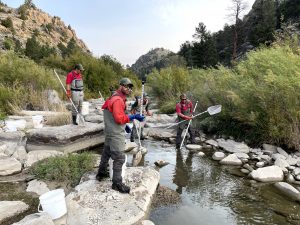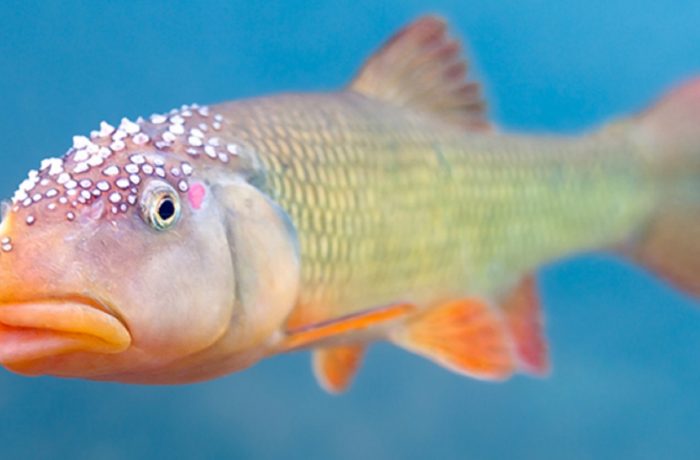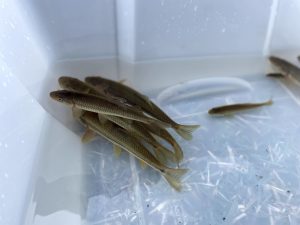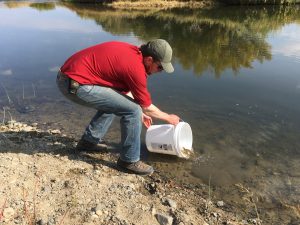How Pisces Molecular Developed an eDNA qPCR Assay to Support the Conservation of a Critically Imperiled Fish Species in Wyoming
|
Most people have never heard of the unassuming hornyhead chub (Nocomis biguttatus), let alone worried about its conservation status. On the IUCN Red List, it’s a species of “Least Concern.” But to Wyoming Game and Fish Department (WGFD) biologists, entrusted with managing over 800 species of wildlife, the six-inch, minnow-like fish is a high priority. Secure through much of its native range, the hornyhead chub is listed by NatureServe as “Critically Imperiled” in Wyoming, Kansas, and Pennsylvania and “Presumed Extirpated” in neighboring Colorado and Nebraska. Wyoming’s state wildlife action plan (SWAP) designates hornyheads as a “species of greatest conservation need” (SGCN) and outlines both the challenges that face the hornyhead chub and the steps WGFD biologists are taking to maintain this native Wyoming species. The hornyhead chub thrives in clear, cold rivers and streams with gravel or sandy bottoms. Male hornyheads build spawning nests with gravel and guard the nests from other hornyhead males using small white tubercles (“horns”) that grow on their heads. The nests, which can reach three feet in diameter, are used not only by hornyhead chubs but also by other fish as well. Habitat loss, siltation, entrainment in irrigation canals, and predation from nonnative fish all threaten the hornyhead chub in Wyoming. In 2010, the hornyhead population in Wyoming was limited to 24 miles of the Laramie and North Laramie rivers; in 2012, the situation worsened when ash and other debris from a wildfire wiped out the population on the North Laramie. Since then, WGFD biologists have reintroduced the hornyhead chub, transplanting 200 fish from the Laramie to the North Laramie in 2014, another 200 in 2015, and more in 2019. In September 2020, they transplanted 300 fish from the Laramie to the Sweetwater River, acting on a historic 1852 mention of hornyhead chubs in the Sweetwater. More transplanting is scheduled for 2021. After reintroducing hornyhead chubs to streams included in their historic range in Wyoming, WGFD wildlife managers faced the challenge of determining the success of their transplant operations. Sampling events to assess the various populations have been plagued by low capture efficiency. Seeking a less costly and labor-intensive way to confirm the continued presence of hornyhead chubs—that is, without mounting major field operations in remote areas—WGFD biologists turned to Pisces Molecular for help. If we at Pisces could develop an environmental DNA assay for qPCR testing, WGFD could confirm the presence of hornyhead chubs in any given stream with water samples that could be easily collected by one person. The first step in creating a successful eDNA assay is to identify genomic differences between the target species and non-target species—usually species that are closely related and/or co-located with the target species. These areas of divergence are potential regions for creating qPCR primers and probes. If this process is successful, the resulting assay (created using the primers and probes) will amplify eDNA from the target species without cross-reacting with the DNA of any of the non-target species. The CO1 gene in the mitochondrial genome is well conserved; because of this, molecular geneticists commonly use it as a point of comparison when designing eDNA assays. It is also commonplace to visually scan the aligned genetic sequences of target and non-target species for regions of maximum divergence. While these procedures have produced many successful assays, we took a different approach in designing the hornyhead chub eDNA assay—an approach that was innovative in two ways. First, we asked, “What if the regions of greatest divergence—and, therefore, the best candidates for qPCR primers and probes—are not on CO1 but on another gene?” Realizing this limitation of the standard approach, we expanded our search to include the entire mitochondrial genome sequence. The second innovation related to the search itself. Even if such a search is limited to one gene—for example, to the approximately 650 base pairs (bp) in CO1—the process of visually scanning for regions of maximum divergence can be quite tedious. It would be even more tedious to visually examine the entire mitochondrial genome sequence (about 16,650 bp) for such regions. Consequently, we designed a computer program that (1) aligns the entire mitochondrial genome sequence of all species of interest (in this case, the hornyhead chub plus 14 other co-located and/or closely related species); and (2) computes and plots the number of sequence differences between the target species and the non-target species. For the hornyhead chub eDNA assay, the four regions identified by our program as having the most divergence were on four different genes—none of them CO1. The final assay design used a 71-bp region of the ND2 gene. The computer program was so successful that we are currently developing a second version, extending its functionality further into the process of identifying specific primer and probe sites with the most mismatches between the target and non-target species. Ultimately, we developed an eDNA qPCR assay sensitive enough to detect the presence of hornyhead chub DNA at the theoretical limit of detection - three molecules of hornyhead DNA in a PCR reaction. This particular assay supports the conservation efforts of WGFD, aiding the reestablishment of the hornyhead chub in its native streams in Wyoming. At the same time, the innovations we developed in working on the hornyhead chub assay—analyzing not just one gene but the entire mitochondrial genome sequence and streamlining the analysis through our software tool—will make future eDNA assay development easier and more precise. |

|



